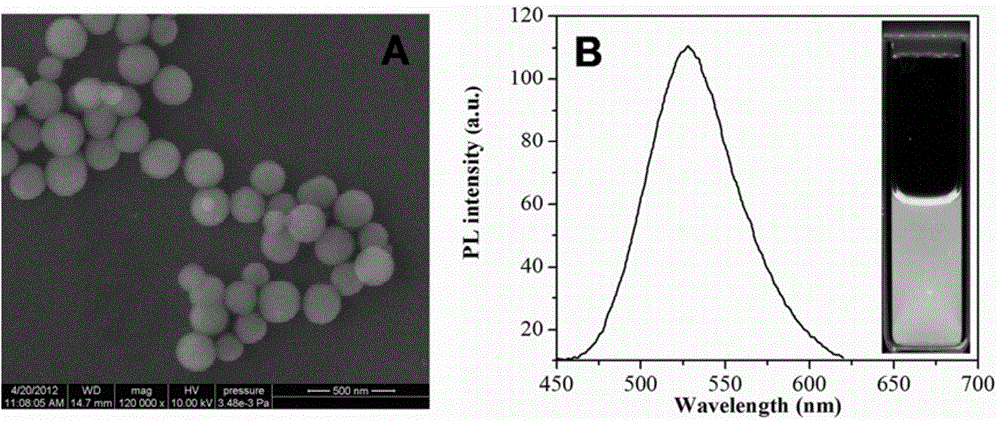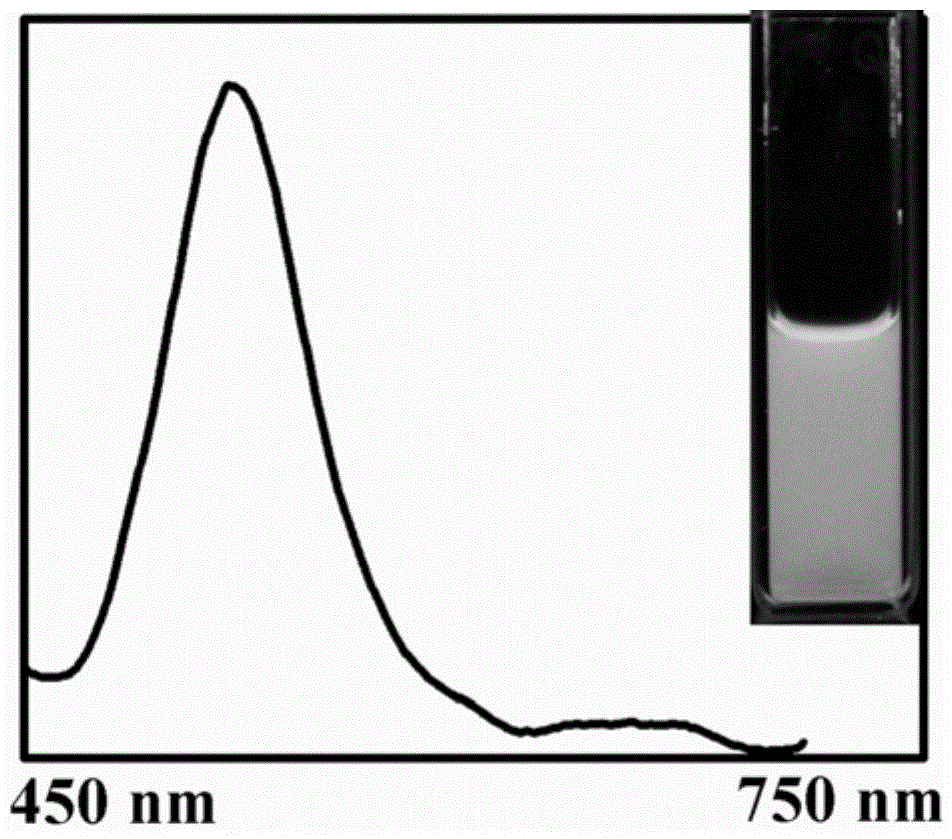A dual-emission fluorescent chemical sensor and its preparation method and application
A chemical sensor and dual-emission fluorescence technology, which is applied in the direction of fluorescence/phosphorescence, material excitation analysis, etc., can solve the problems of inconvenient detection and poor stability, and achieve the effect of omitting the pretreatment process, avoiding interference, and being suitable for carrying around
- Summary
- Abstract
- Description
- Claims
- Application Information
AI Technical Summary
Problems solved by technology
Method used
Image
Examples
Embodiment 1
[0036] Example 1: Preparation of dual emission quantum dot-porphyrin ratio fluorescent probe
[0037] 1. Preparation of cadmium telluride quantum dots
[0038] 0.2284g cadmium chloride (CdCl 2 2.5H 2 O) Add to 250mL ultrapure water, then add 0.21mL mercaptopropionic acid, and then adjust its pH value to 11 with 1M NaOH solution to form a solution containing mercapto compounds and cadmium ions. On the other hand, take 0.0319g of tellurium powder and 0.05g of sodium borohydride in 2mL of deoxygenated ultrapure water, and react in an ice bath for more than 8 hours under the protection of nitrogen. Inject 5mL of 0.5M dilute sulfuric acid solution into the resulting sodium hydride telluride solution. will generate H 2 Put all the Te into the cadmium ion solution, stir for 20 minutes, and then heat to reflux. By controlling the reflux time, an aqueous solution of cadmium telluride quantum dots with stable mercaptopropionic acid and a fluorescent emission peak at 490-680 nm can ...
Embodiment 2
[0044] Embodiment 2: Quantitative detection of nitrogen dioxide solution
[0045] Add the sample solution containing nitrogen dioxide to be detected to the ethanol solution of the fluorescent probe prepared in Example 1 for fluorescence detection. Nitrogen dioxide has a response at a content of 0.4 μM, and the detection is very sensitive. As the addition time of nitrogen dioxide solution gradually increased, the green fluorescence intensity of quantum dots remained unchanged, while the red fluorescence of porphyrin gradually recovered until it was no longer enhanced. At this time, under the ultraviolet lamp, it can be seen that the fluorescence of the probe changes from bright green to yellow, and the nonlinear relationship between the ratio of the double emission fluorescence intensity and the reaction time of nitrogen dioxide is established accordingly. In addition, within a certain trace concentration range, the fluorescent probes all have significant changes, so that the ...
Embodiment 3
[0046] Example 3: Visual detection of nitrogen dioxide pollutants in the air by a dual-color quantum dot-porphyrin superstructure silicon oxide nanoparticle sensor
[0047] Take a small amount of the ratio probe and drop two points on the inner surface of the vial without fluorescent background, use a hair dryer to quickly evaporate the solvent of the probe, and form a thin film on the inner surface of the vial, two bright green in the vial can be seen under the ultraviolet light Therefore, a small vial fluorescent sensing device that is easy to carry and can quickly and visually detect nitrogen dioxide pollutants in the air is designed. The specific operation steps are as follows: inject 1ppm, 10ppm, 100ppm, and 1000ppm nitrogen dioxide gas samples into the vial respectively, observe the color change of the fluorescent bright spots in the vial under the ultraviolet light within 2min, 5min, 10min, and 20min, and you can find bright green fluorescent spots eventually become red...
PUM
 Login to View More
Login to View More Abstract
Description
Claims
Application Information
 Login to View More
Login to View More - R&D
- Intellectual Property
- Life Sciences
- Materials
- Tech Scout
- Unparalleled Data Quality
- Higher Quality Content
- 60% Fewer Hallucinations
Browse by: Latest US Patents, China's latest patents, Technical Efficacy Thesaurus, Application Domain, Technology Topic, Popular Technical Reports.
© 2025 PatSnap. All rights reserved.Legal|Privacy policy|Modern Slavery Act Transparency Statement|Sitemap|About US| Contact US: help@patsnap.com



